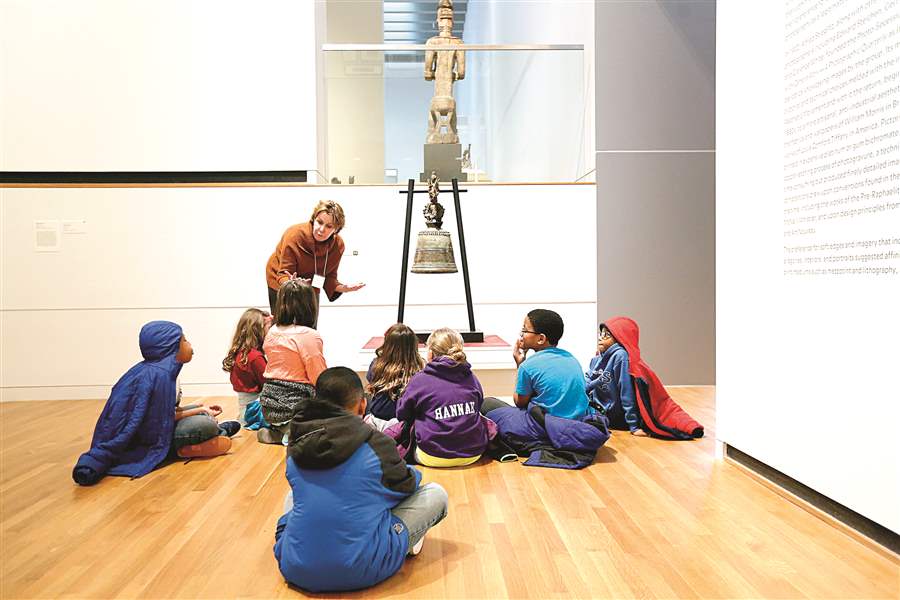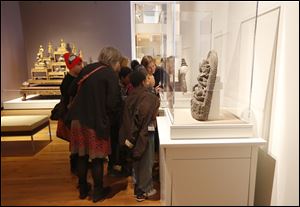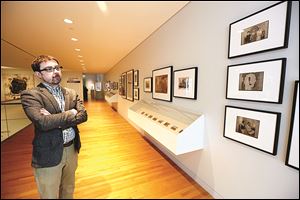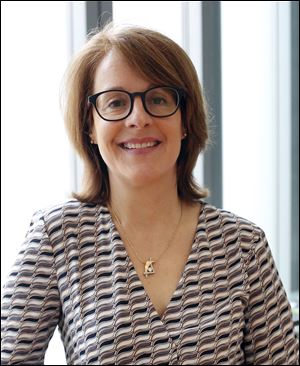
Engaging offer: Some museums ditching membership fees
Institutions bank on free memberships to raise revenue
4/14/2017
Docent Suzanne Arndt talks to a school group about ‘Temple Bell’ from Myanmar inscribed in 1907 at the University of Michigan Museum of Art in Ann Arbor.
The Blade/Amy E. Voigt
Buy This Image
ANN ARBOR — The University of Michigan Museum of Art wants to better engage with its visitors.
All 250,000 of them each year.
The museum has joined a small but slowly growing group of art institutions that have eliminated paid membership tiers.
“If someone walked through the museum, had a great time and then left without visiting the store, without signing up for our newsletter, without joining, they may never hear from us again,” said Justin Reash, UMMA’s assistant director of development, annual giving, and events. “This [move] cements and produces a relationship, free of charge, for us to communicate to them, and hopefully they reciprocate by coming back to the museum and becoming an annual donor.”

A school group looks at statues at the University of Michigan Museum of Art. The facility, which was founded in 1856, attracts about 250,000 visitors each year.
Under the new system, the burden to bring in additional operating revenue shifts from membership to donorship. The public institution, founded in 1856 in the Alumni Memorial Hall near downtown Ann Arbor, added about $175,000 in membership dues to an operating budget that in fiscal year 2015-16 was at $5.9 million.
Since its implementation at the end of January, the free membership program has expanded the museum’s membership pool from 1,200 to almost 7,000 as of April 1, said Carrie Throm, deputy director of development and external relations.
“We did a lot of research on how can we flip this conversation and make it more about deeply engaging with the people who care about this place,” Throm said, “giving them the opportunity to learn more, to be more engaged with our exhibitions, our programs, to get their friends involved, to come to an open house, to come to a family arts studio program, and then be able to have an informed conversation about making a gift in support of the museum.”
About 78 percent of the public institution’s multimillion-dollar budget comes from the University of Michigan, Throm said. In eliminating paid memberships, the museum aims to bring in 15 percent of the budget through grants, contributions, and fund-raising.

Dave Lawrence, communications manager, looks at the exhibit ‘Constructing Gender: The Origins of Michigan’s Union and League.’
Most private museums have stuck with paid membership programs, the Toledo Museum of Art among them. It has membership tiers from $35 to $10,000, offering a range of benefits.
“Because TMA does not benefit from city or county tax dollars, the success and growth of the museum depends largely on the dedicated individuals and businesses who support our mission of integrating art into the lives of people,” TMA states on its website.
TMA markets itself as a free-admission museum, six days a week, that offers most of its special exhibitions at no additional cost.
When contacted, both the Association of Art Museum Directors and the American Alliance of Museums said they don’t track which museums offer free membership or paid programs. At least three other museums in the last few year’s have implemented programs similar to UMMA’s: the Yale University Art Gallery, the University of Florida’s Harn Museum of Art in Gainesville, and the Dallas Museum of Art.
The Yale museum launched its free membership platform in July, 2013, and has had great success, said Jill Westgard, deputy director for advancement. The academic museum increased its membership from 1,200 to 12,000, gaining members from all 50 states and more than 30 countries.
Its funding more than tripled after the move. The museum brought in $80,000 in paid membership revenues in the program’s final year, 2013; in fiscal year 2016, the museum collected $300,000 through its replacement annual fund drive, Westgard said.
“The motivation was really looking at our philosophy of making our resources available as widely as possible and trying to eliminate barriers to people of all kinds being able to use our museum,” Westgard said.
Like the paid memberships, the free ones at participating museums come with perks: monthly newsletter mailings, magazine subscriptions, discounts at museum stores, and free admission at participating museums. The new initiative is part of the University of Michigan museum’s strategic plan and is being promoted through a $35,000 grant from the Community Foundation for Southeast Michigan.

Throm
“We don’t want to remain under the myth or notion that to be a stakeholder in the museum you have to be a wealthy patron,” Throm said.
The UMMA launched its new initiative during the first phase of Figuration, a major exhibition highlighting the collections of the university’s alumni and commemorating the 200th anniversary of the university’s founding. Figuration runs through June 11. (The show’s second installment, Abstraction, runs July 1 to Oct. 29).
It also came after a 53,000-square-foot addition in 2009 that allowed the museum to offer more special exhibitions and open gallery spaces for its 20,000-plus piece collection.
The Association of Academic Museums and Galleries, a support organization for academic museums with more than 600 members, will hear in September whether it has secured a $78,544 grant from the Institute of Museum and Library Services to fund a comprehensive survey of its membership. Among other topics, the survey would look at museum funding, memberships, and fund-raising and donor drives to determine what works and what doesn’t.
“Those are the types of questions we will be asking,” said John Versluis, the mountain plains regional representative for the association and the dean of the Texas Heritage Museum at Hill College in Hillsboro, Texas.
Versluis said the issue of membership and donorship can spotlight the importance of creative, educational institutions in communities and what excites donors to support museums.
He points to his museum’s use of more than 10,000 square feet of exhibition space for hands-on teaching, including a museum theater. The nontraditional teaching methods by Hill College faculty attracted hundreds of students.
“I think, if we did do a fun drive like this, would we get them, later, as an alum, donating? Maybe down the road they would [give],” he said.
Contact Roberta Gedert at: rgedert@theblade.com or 419-724-6075 or on Twitter @RoGedert.